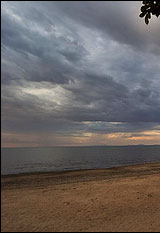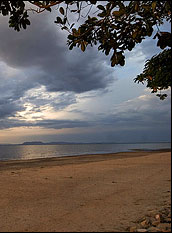

 The caravan…began winding up a long but gradually inclined hill until it reached its summit, when the vast expanse of the pale-blue waters of the N’yanza burst suddenly upon my gaze. It was early morning. The distant sea-line of the north horizon was defined in the calm atmosphere between the north and west points of the compass; but even this did not afford me any idea of the breadth of the lake….This view was one which, even in a well-known and explored country, would have arrested the traveller by its peaceful beauty. —John Hanning Speke, August 3, 1858. Though pastoral when British explorer John Hanning Speke became the first European to explore its shores, today, Lake Victoria in East Africa is one of the most populous regions in the world. The lake provides food, transport, and electricity to more than 30 million people, but its resources are limited. Despite its impressive size—it’s the third-largest lake in the world—Lake Victoria is shallow, resembling, in Speke’s words, “the temporary deposit of a vast flood overspreading a large flat surface.” Until the Owens Falls Dam began to regulate water levels from the lake’s only outlet in 1954, the amount of water in the lake jumped drastically from year to year depending on rainfall. Though water levels continued to vary after the dam was built, they remained more than 11.9 meters above a gauge in Jinja, Uganda. But in early 2006, the Jason-1 satellite revealed that Lake Victoria had reached lows not seen since well before the dam was built. |

Sunset over Speke Bay, Lake Victoria. (Photograph copyright Hartmut Ulrich.) | ||
 | |||
The dramatic drop in water levels at Lake Victoria was revealed during routine monitoring conducted by the Global Reservoir and Lake Monitor Project, a partnership between NASA and the U.S. Department of Agriculture (USDA). “It’s a general practice [in crop monitoring] to look at the water supply, and one of the tools to do that is to look at reservoir heights. Reservoirs show how much long-term water storage is available,” says Curt Reynolds, an agricultural analyst and hydrologist who monitors crop conditions in Africa for the USDA’s Foreign Agricultural Service. But water-level data are not always easy to obtain through on-site measurements: the lakes may be hard to get to, gauges can be inaccurate, or local governments may not want to share that information. The Foreign Agricultural Service monitors lakes and reservoirs with the radar altimeter on the Jason-1 satellite, operated jointly by NASA and the Centre National d’Etudes Sptiales (CNES), the French space agency. “Jason-1 emits microwave pulses towards the Earth’s surface,” says Charon Birkett, the University of Maryland researcher that heads up the team that prepares data for the Foreign Agricultural Service. The water height influences how long it takes the microwave “echo” to return to the satellite. “Lake Victoria is such a big lake that you get lots of echoes as the satellite goes across it,” says Birkett. As a result, the water-level measurements are accurate to within 3-5 centimeters. “Considering that Jason is 1,300 kilometers up there, that’s pretty good,” Birkett adds. The accuracy means that analysts like Reynolds can use Jason-1 data—data that are immediately available on a weekly basis compared to less frequent and less timely ground measurements—to extend a lake’s historical record collected from gauges. “The fit [agreement] is good between the radar altimeter and the gauge measurements,” says Reynolds. A longer record provides the perspective that resource managers need to understand what current changes in water levels mean for a particular lake and the surrounding region. |
Lake Victoria is located in East Africa, bordered by Kenya, Tanzania, and Uganda. (Map by Robert Simmon and Reto Stöckli.) | ||
 |
 | ||
In the case of Lake Victoria, the story told by water levels is complicated. Thirteen years of measurements taken by satellite radar altimeters combined with historical ground measurements reveal Lake Victoria’s volatile past. In the 105-year history of accurate measurements on the lake, water levels have fluctuated widely. In 1961 and 1962, for example, heavy rain drove water levels up by an astounding 2 meters. Since that time, levels above the gauge in Jinja, Uganda, stayed above 11.9 meters (about 1,134 meters above sea level) until December 2005. From that point, water levels dropped to alarmingly low levels and were not expected to stop dropping until the April rains arrived. |
Water levels in Lake Victoria were unusually high from the mid-1960s until December 2005. Since then water levels dropped roughly a meter, threatening the communities that rely on the lake for water, work, power, and food. Lake level data from the TOPEX-Poseidon and Jason-1 satellites (red) augment gauge data at Jinja, Uganda (black). (Graph by Robert Simmon, based on data provided by the USDA Foreign Agricultural Service.) | ||